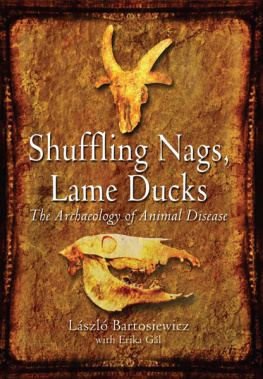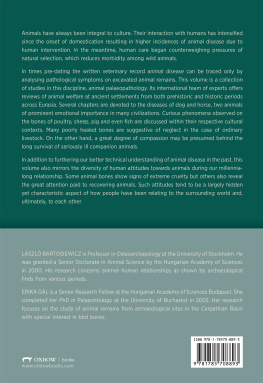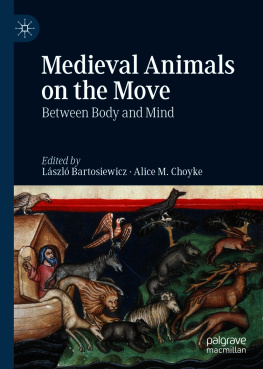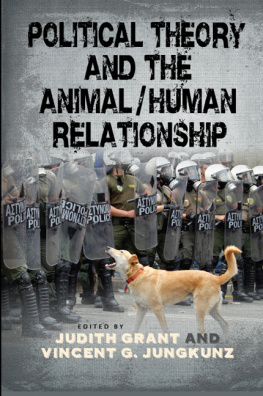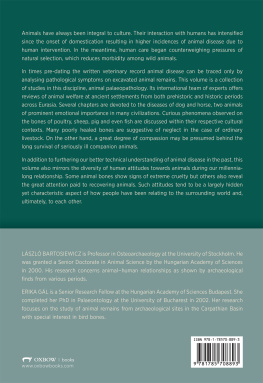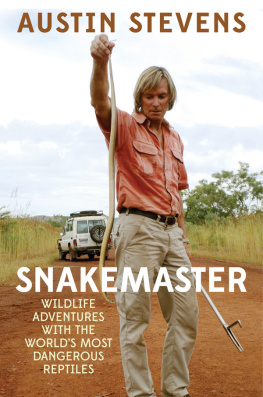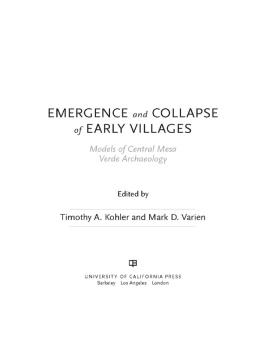Published by
Oxbow Books, Oxford, UK
Oxbow Books and the individual authors, 2013
Paperback ISBN 978-1-78297-189-4
E-pub ISBN 978-1-78297-194-8; Mobi ISBN 978-1-78297-195-5;
PDF ISBN 978-1-78297-196-2
This book is available direct from
Oxbow Books, Oxford, UK
(Phone: 01865-241249; Fax: 01865-794449)
and
The David Brown Book Company
PO Box 511, Oakville, CT 06779, USA
(Phone: 860-945-9329; Fax: 860-945-9468)
or from our website
www.oxbowbooks.com
A CIP record is available for this book from the British Library
Library of Congress Cataloging-in-Publication Data
Bartosiewicz, L.
Shuffling nags, lame ducks : the archaeology of animal disease / Lszl Bartosiewicz ; with a
contribution on avian palaeopathology by Erika Gl.
pages cm
Includes bibliographical references and index.
ISBN 978-1-78297-189-4
1. Animal remains (Archaeology) 2. Animals--Diseases. I. Gl, Erika. II. Title.
CC79.5.A5B374 2013
930.1--dc23
2013033096
Cover Ian Hughes, www.mousematdesign.com.
Printed in Great Britain by
Short Run Press, Exeter
Contents
Acknowledgements and photo credits
Studying animal diseases in the past on the basis of archaeological evidence alone has been a complex task. Producing this book would have been impossible without substantial help by a number of people. Initiative by the late Sndor Bknyi must be acknowledged for compiling a core of data on pathological finds that have recently been substantially expanded by fellow archaeozoologists and archaeologists in Hungary who generously released information for analysis and publication. They include (in alphabetical order) Anna Zsfia Biller, Clive Bonsall (UK), Alice M. Choyke, Pter Csippn, Lszl Darczi-Szab, Mrta Darczi-Szab, gnes Kirly, Zsfia Eszter Kovcs, Andrea Krsi, Kyra Ljubljanovics, Fabiana Martin (Argentina), va Nyerges, Gbor Szrnyi, Darren Tanke (USA), Beta Tugya and Ivan Turk (Slovenia). Grateful thanks are due to Alice M. Choyke for having corrected the English version of the manuscript and Krisztin Kolozsvri who helped with the technical edition of photographs. Mihly Gasparik is thanked for providing access to the bird bone collection housed in the Department of Geology and Palaeontolgy of the Hungarian Natural History Museum, Budapest, as well as Andrea Krsi for help in the Hungarian Agricultural Museum, Budapest. We are indebted to Pter Stonyi and Rbert Bozi, veterinarians, for their expert opinion on several excavated specimens.
The topic of this book is complex. Lengthy descriptions would be incomprehensible without the illustrations provided by several individuals and organizations whose initials will appear in figure captions throughout the book: Attila Arany Tth (AAT) and the late Bla Zsadon (BZs) prepared radiographs. Anna Zsfia Biller (AZsB) contributed both photographs and drawings. Additional photographs were taken by Marcel Balogh (MB), Clive Bonsall (UK), Alice M. Choyke (AMC), Ferenc Csecsetka (FCs), Pter Csippn (PCs), Lszl Darczi-Szab (LDSz), Mrta Darczi-Szab (MDSz), Erika Gl (EG), Julia Gerken (JG), rpd Gereffy (G), Jnos Gyarmati (JGy), Istvn Konyhs (IK), Istvn Kovts (IKo), Kroly Kozma (KK), Kyra Lyublyanovics (KL), Fabiana Martin (FM), Pia Nielsen (PN), Krisztina Plfay (KP), Joris Peters (JP), Aleks Pluskowski (AP), David L. O. Smith (DOLS), Lszl Susits (LS), Gbor Szllsy (GSz), Diana-Maria Sztancs (DMS), Dina Tasi (DT), Tibor Tth (TT), Zsuzsanna Tth (ZsT), Beta Tugya (BT) and Ivan Turk (IT). Their indispensable help is gratefully acknowledged here.
Institutional help was received through Csand Blint, director of the Archaeological Institute of the Hungarian Academy of Sciences (HAS), who kindly released numerous photographs for publication. Richard H. Meadow, director of the Zooarchaeology Laboratory, Peabody Museum, Harvard University (PMHU) gave permission to republish the image of horse vertebrae from Kurru, Sudan. Special thanks are due to Soraida Salwala, founder of the organization Friends of the Asian Elephant (FAE) and Istvn Konyhs (IK) of the Hungarian Bird Hospital Foundation and the agency Fot gynksg (www.Fotougynokseg.com) who contributed special pictures on animal welfare to this book. Additional pictures were provided by Agenca Efe (EFE), Bildagentur fr Kunst, Kultur und Geschichte, Berlin (BPK), Det Kongelige Bibliotek, Kbenhavn (KB) and Solent News and Photo Agency (SOLENT).
During 20042006 research included in this book was funded by Grant T047228 of the Hungarian Scientific Research Fund (OTKA) titled Anatomical and pathological investigations on the skeleton of domestic animals: the use of recent observations in the interpretation of archaeological finds.
1. Foreword
Some 10,000 years ago, a handful of animal species were first incorporated within the human habitat on a permanent basis. Their reproduction and well-being became directly dependent on their keepers. As domestication progressed, physical proximity became a mutual source of infectious disease and traumatic injuries for humans and animals alike. New zoonoses developed, diseases and infections which are naturally transmitted between vertebrate animals and man (Shakespeare 2002, 1). An evident example of such diseases is rabies, known to spread through dog bites to other animals and humans. This disease was described as early as the 13th century by, among others, Albertus Magnus (Walker-Meikle 2012, 47). The written record provides accounts of other epidemics threatening livestock as well as humans. A dramatic woodcut in the 1532 German edition of Francesco Petrarchs 1492 De remediis utriusque fortunae (Medicine Against Both Fortunes II) shows a tumultuous plague scene in which victims not only include people, but also a horse, a dog, a cat, a rooster, and even a perching bird ().

Figure 1. Plague scene in the 1532 German edition of Petrarchs book

Figure 2. Stray pig scavenging on an urban dump near Agra, India
It is however, not only epidemics, usually elusive from an archaeological point of view, that have emerged as people and animals have co-existed. In addition to physical closeness, modes of animal keeping and exploitation have continuously resulted in non-infectious diseases whose treatment or neglect can be recognized on the skeleton of ancient animals. Such phenomena not only reflect the health condition of livestock, but are characteristic of cultural attitudes towards animals. The slogan attributed to the 1904 Nobel Prize laureate Ivan Petrovich Pavlov: Doctors treat people, veterinarians humanity, is as relevant in our modern society as has been the special attention devoted to emotionally significant and/or valuable animals in the past.
Traditional animal palaeopathology was rooted in palaeontology, with little or no interest in the cultural aspects of animal disease. Animal remains recovered from archaeological deposits, however, are bona fide archaeological artefacts: they represent the cumulative effects of human decisions that in man-made domesticates include choices made during an animals life including selective breeding and the treatment of disease. Implicit to the concept of this book is, therefore, the hypothesis that most pathological deformations in archaeozoological specimens were brought about by conscious or inadvertent human influence.
Wild animals appear at first glance rather peripheral to the archaeological study of animal disease. Once domestic animals appeared they provided the majority of meat for their human keepers and thus soon became the dominant component in archaeological bone assemblages. The statistical probability of finding odd pathological specimens among the few wild animal remains therefore radically decreased. In addition, aside from hunting injuries, only a relatively limited range of diseases affect the skeletons of game: natural selection rarely allowed the development of chronic conditions seen in domestic animals. It is this contrast however, that offers a new perspective in the palaeopathological study of wild animal remains.
Next page
